

Android Authority. ISTE Poster Session Flyer. Raincatch Water Purifier Will Soon End Water Scarcity. 6 Water-purifying Devices for Clean Drinking Water in the Developing World. With 3.575 million people dying each year from water-related disease, our current water crisis is one of epic proportions.
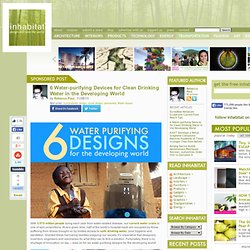
At any given time, half of the world’s hospital beds are occupied by those suffering from illness brought on by limited access to safe drinking water, poor hygiene and sanitation. Granted these harrowing realities plaguing our society, it’s imperative that designers, inventors, engineers and visionaries do what they can to find a solution. Fortunately, there’s no shortage of innovation on tap – read on for six water purifying designs for the developing world! 1. Lifestraw The Lifestraw is a small cigar-shaped tube packed with some truly innovative engineering. 2. Filtron.jpg (250×350) Designing a Water Purification System for Developing Communities. Solar Water Purification System Testing Today! Drinking Water – it’s a problem.
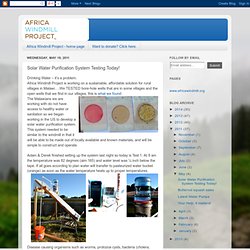
Africa Windmill Project is working on a sustainable, affordable solution for rural villages in Malawi….We TESTED bore-hole wells that are in some villages and the open wells that we find in our villages, this is what we found: The Malawians we are working with do not have access to healthy water or sanitation so we began working in the US to develop a solar water purification system. This system needed to be similar to the windmill in that it will be able to be made out of locally available and known materials, and will be simple to construct and operate. Adam & Derek finished setting up the system last night so today is Test 1. At 8 am the temperature was 82 degrees (aim 165) and water level was ¼ inch below the tape. WaterFilterSchematic.png (360×315) y2ktripod.jpg (507×383)
628x471.jpg (628×471) 14-Year-old is America's Top Young Scientist: Her Solar-Powered Jug Purifies Water. Resources/DIY.pdf. Low-Cost Water Purification System: Developing an Effective Water Purification System for Local Production Which Offers Sustainable Economic Stimulus. EPA Grant Number: SU833176Title: Low-Cost Water Purification System: Developing an Effective Water Purification System for Local Production Which Offers Sustainable Economic StimulusInvestigators: Khalili, N.
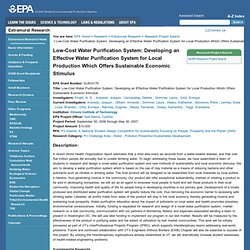
R. WATER PURIFICATION SYSTEM, cheap and effective. SO YOU HAVE an emergency supply of water, but you're not sure how pure it is.
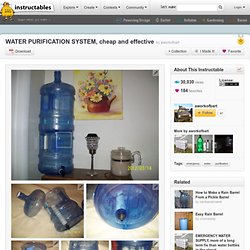
Here is an excellent, cheap setup you can easily DIY for purifying LOTS of water. It's based on the Berkey ceramic water element filtration system that's been around for a long time. LOOK ON AMAZON FOR "DOULTON" FILTERS. Water purification methods. Pocket : Ip (improvised water filter) Ip (improvised water filter) Filter Types and Technologies. Although there are hundreds of brands of home water filters, they all rely on a small number of technologies to remove contaminants.
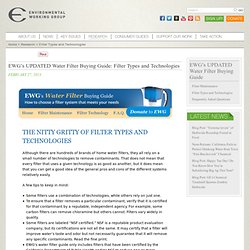
That does not mean that every filter that uses a given technology is as good as another, but it does mean that you can get a good idea of the general pros and cons of the different systems relatively easily. A few tips to keep in mind: Some filters use a combination of technologies, while others rely on just one. To ensure that a filter removes a particular contaminant, verify that it is certified for that contaminant by a reputable, independent agency.
For example, some carbon filters can remove chloramine but others cannot. Carbon/Activated Carbon: Activated carbon chemically bonds with and removes some contaminants in water filtered through it. Carbon Block: Carbon block filters contain pulverized activated carbon that is shaped into blocks under high pressure. Granulated Activated Carbon: These filters contain fine grains of activated carbon. EWB biofilter project benefits one village today...tomorrow, the world! - Engineering at Illinois. What if, in addition to earning a degree from a top-ranked engineering program, you could actually change the lives of several million people?

(l to r) Peter Maraccini, Ofelia Romero, Thomas Van Dam, Paulino, Alejandro, Ovidio, Rolando, Kim Parker, Emily Van Dam, Alyssa Sohn, and Anne Kreamer Diaz. For several years, the Mayan community of Socorro, Guatemala was afflicted with acute and chronic gastrointestinal diseases stemming from poor drinking water quality, soil-transmitted helminthes (worm) infections, and malnutrition. During the beginning of the rainy season, diarrheal rates in children exceeded 75%, resulting in missed school, emotional and economical stress on their families, and occasionally death.
In an attempt to alleviate their drinking water crisis, the people of Socorro assembled a council and, with the help of Wuqu’ Kawoq, a U.S. Guatemalan construction workers pouring concrete in biosand filter mold. Several completed filters at the end of the day. Water Filter Project. Water-borne diseases kill more children in Haiti than anything else except related diseases from malnutrition.
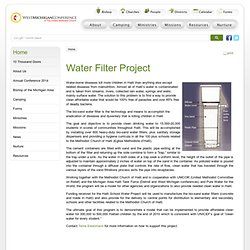
Almost all of Haiti’s water is contaminated and is taken from streams, rivers, collected rain water, springs and wells; mainly surface water. The solution to this problem is to find a way to provide clean affordable water that would be 100% free of parasites and over 85% free of deadly bacteria. Ten low-cost ways to treat water. Having money helps, but clean water doesn't have to be expensive.
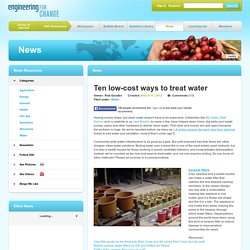
Celebrities like Bill Gates, Matt Damon and, a celebrity to us, Ned Breslin, to name a few, have helped clean rivers, dig wells and install pumps, pipes and other hardware to deliver clean water. Their time and money are well spent because the problem is huge. As we've reported before, as many as 1.8 million people die each year from diarrhea linked to bad water and sanitation, most of them under age 5. Community-wide water infrastructure is as good as it gets. Water Filter Design Process Test. So while working on the project I have come across many tasks that were needed to be completed.
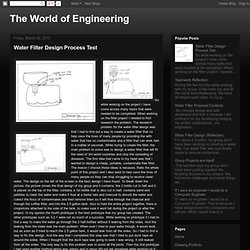
When working on the filter project I needed to first research the problem. Access to safe water and sanitation. Learning areas English Year 5 Identify aspects of literary texts that convey details or information about particular social, cultural and historical contexts (ACELT1608) Plan, rehearse and deliver presentations for defined audiences and purposes incorporating accurate and sequenced content and multimodal elements (ACELY1700) Year 6.
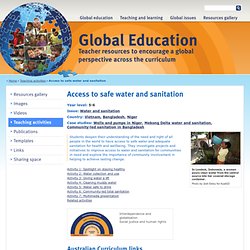
Water and sanitation. Water and sanitation. The right to water and sanitation Water is the source of life – vital for health, food and economic development. Without sufficient and affordable clean water and access to adequate toilet and washing facilities, people suffer a range of illnesses. As a result, they may be unable to work or attend school. Without water to grow crops people may go hungry. Without health and education people have less chance of earning an income and become trapped in a brutal cycle of illness and poverty. Filtration of Water Science Fair Project. Purpose To remove suspended matter from muddy water in three stages: using sedimentation, filtration as well as chemical treatment Additional information Muddy water, which ideally is discolored owing to a high amount of suspended particles, can be turned into clear water devoid of the particulate impurities.
This however, is not necessarily ‘pure water’ since disease causing germs such as bacteria or viruses which cannot be seen with the naked eye may still be present in the clear liquid. These microscopic pathogens are so small that they cannot be removed by simple processes like sedimentation or filtration; instead these require specialized treatments or at least boiling to minimize the risk that they bring along. Sponsored Links Required materials Muddy waterThree beakersGlass funnelStand with holderFilter paperGlass rodTwo tall jarsAlum Estimated Experiment Time Approximately 5 to 8 hours Step-By-Step Procedure. Conclusion of Seminivka 1st School Water Filter Project – Ukraine.
This project has been completed under the direction of Peace Corps Volunteer Chris Hagel. To read about the beginning of the project, CLICK HERE. Fun Projects. Sand water filter science project + video. It covers two-thirds of the Earth's surface and makes up about 60% of adult's bodies, including 75% of our brains! Each day we need to consume more than two liters of the stuff—through liquids we drink and foods we eat. Although there's plenty of H2O around, much of it is either inaccessible or inconsumable to humans. Rainwater Harvesting and Purification System.